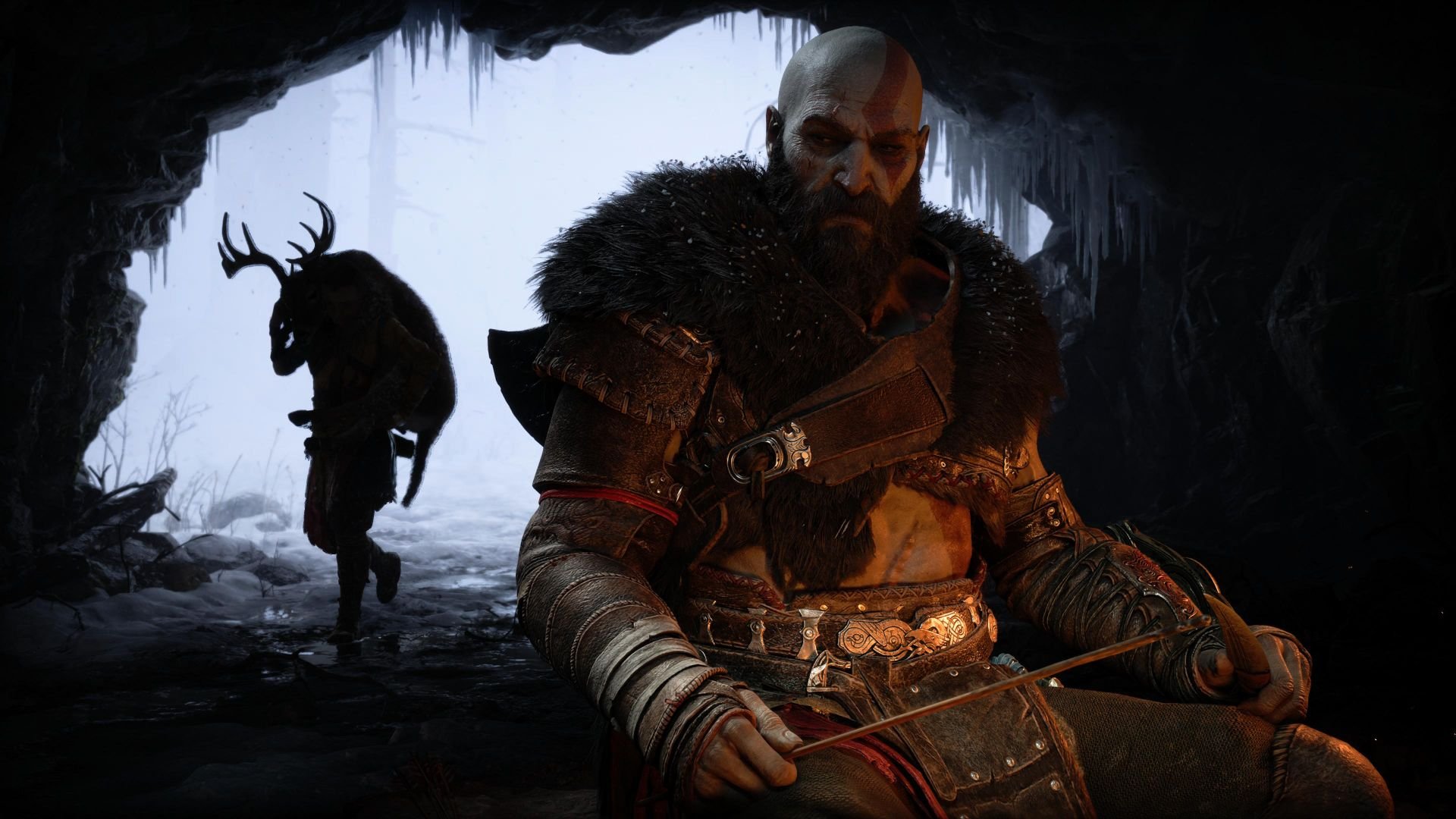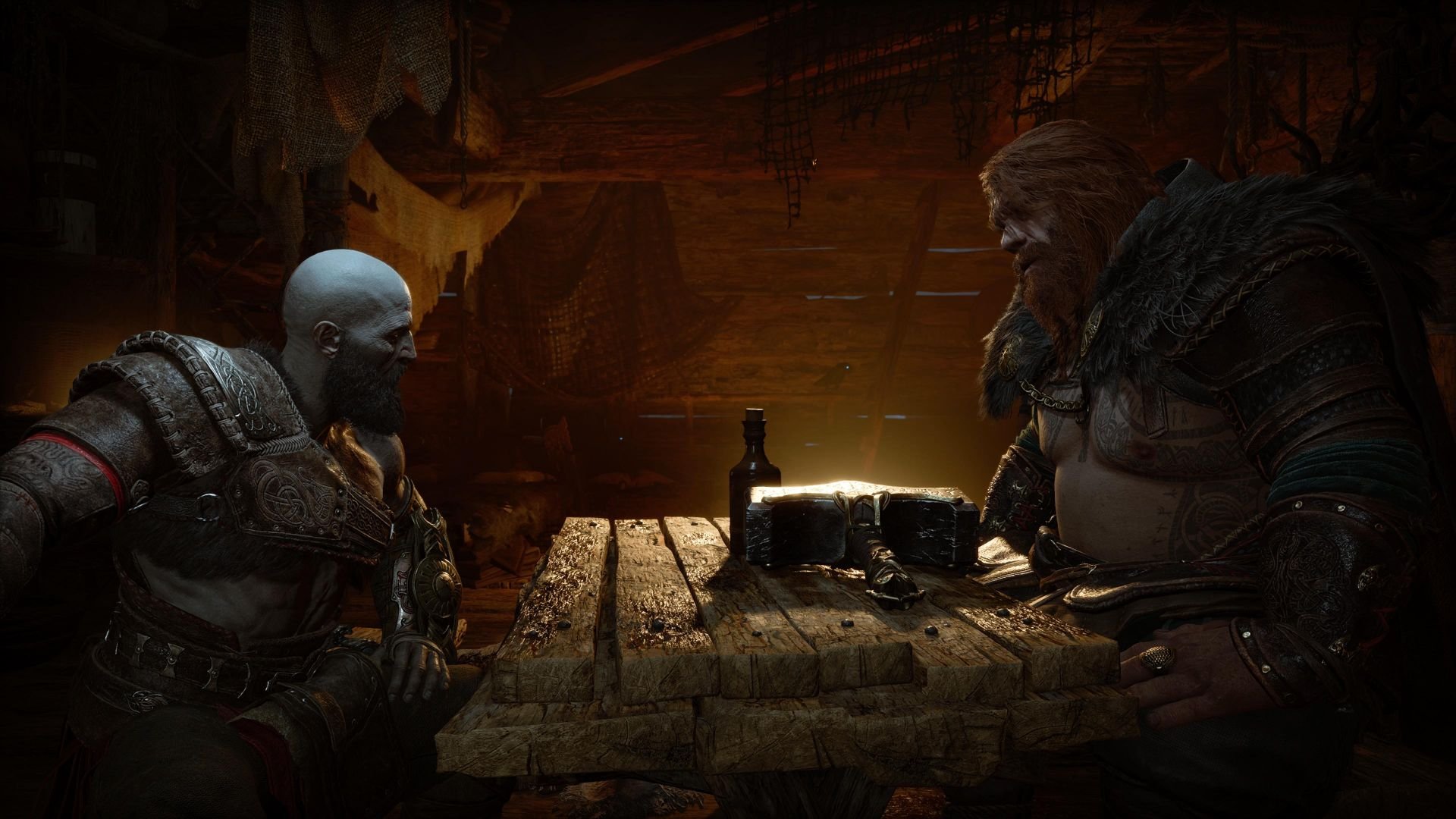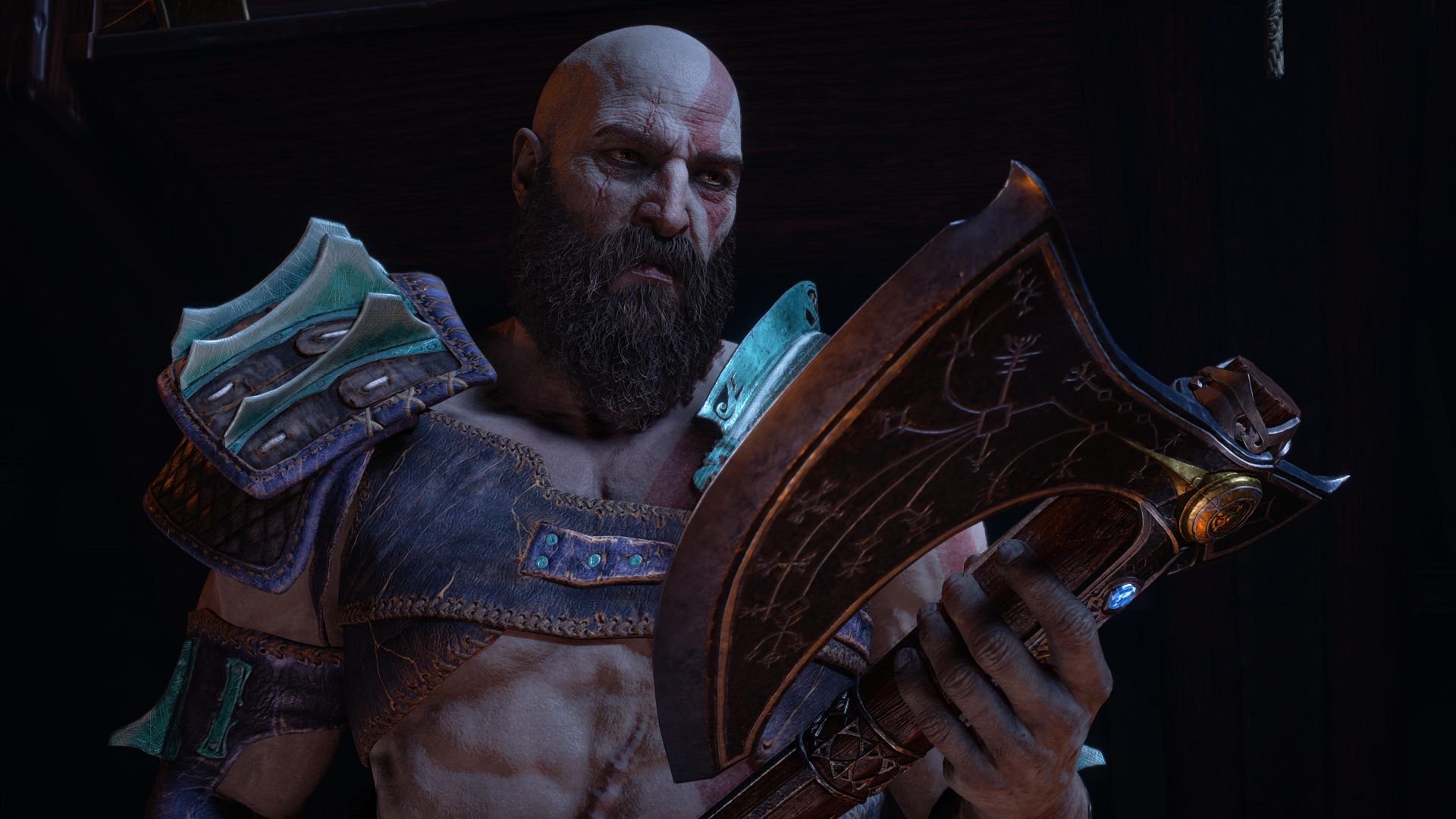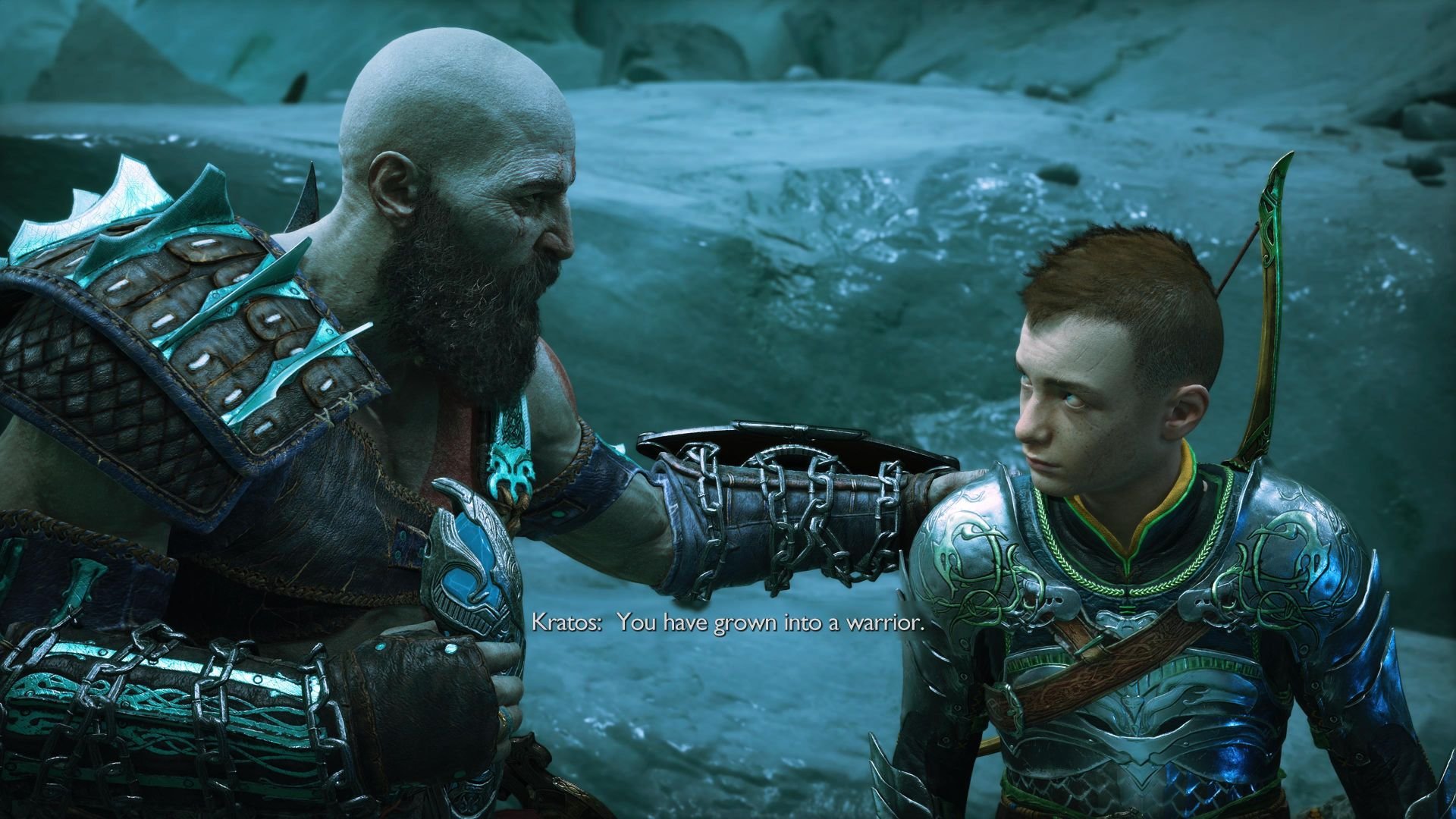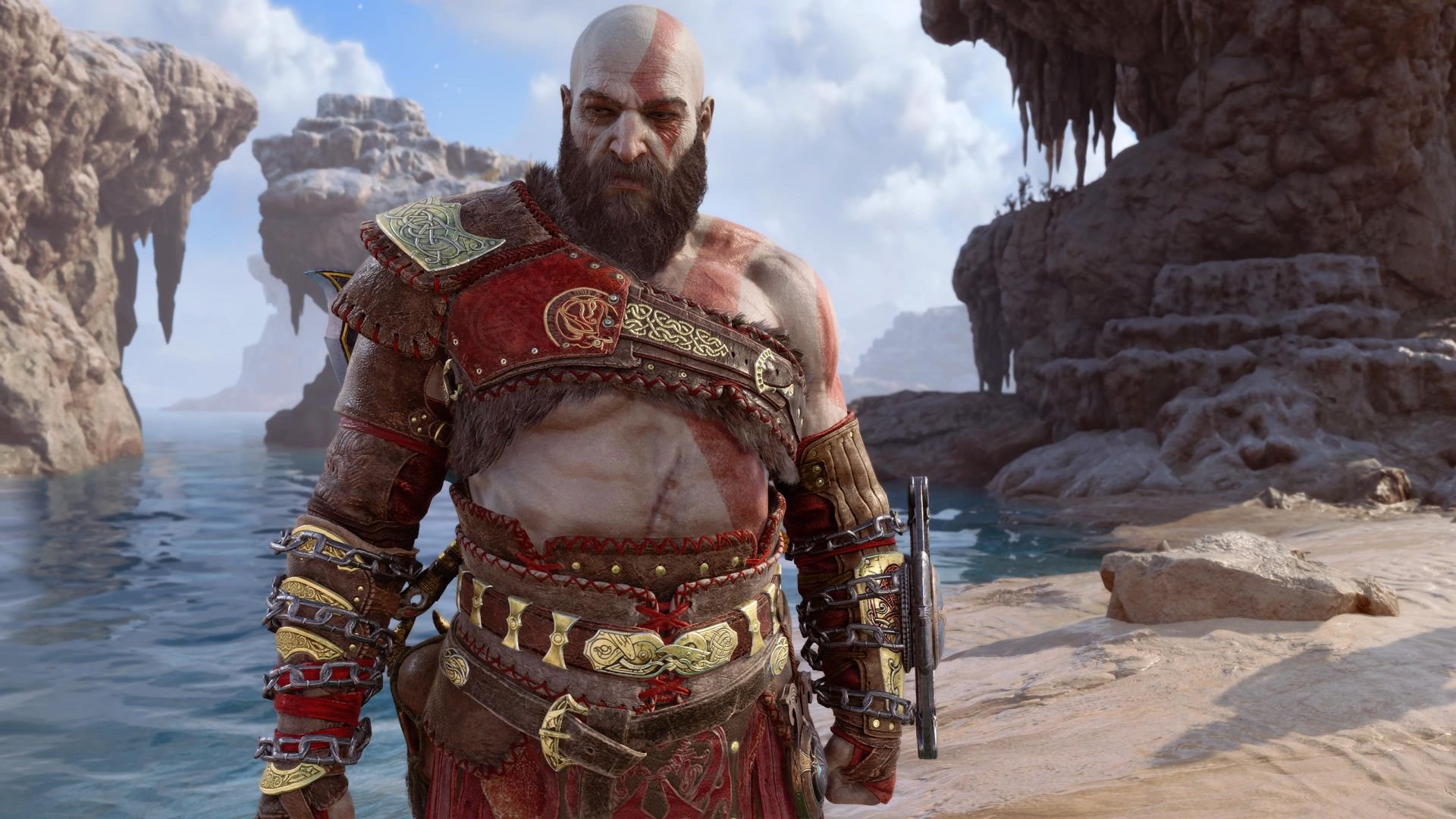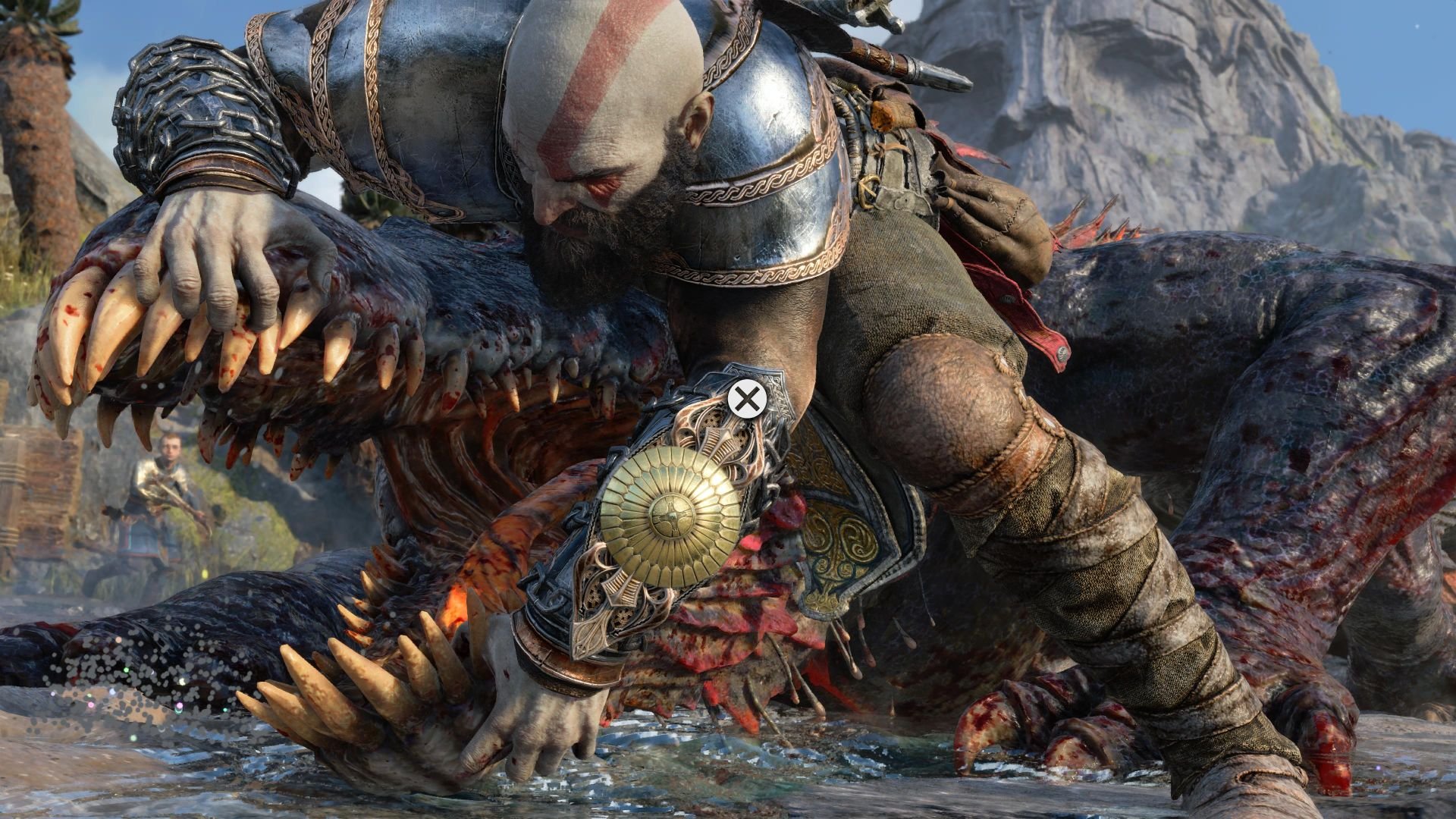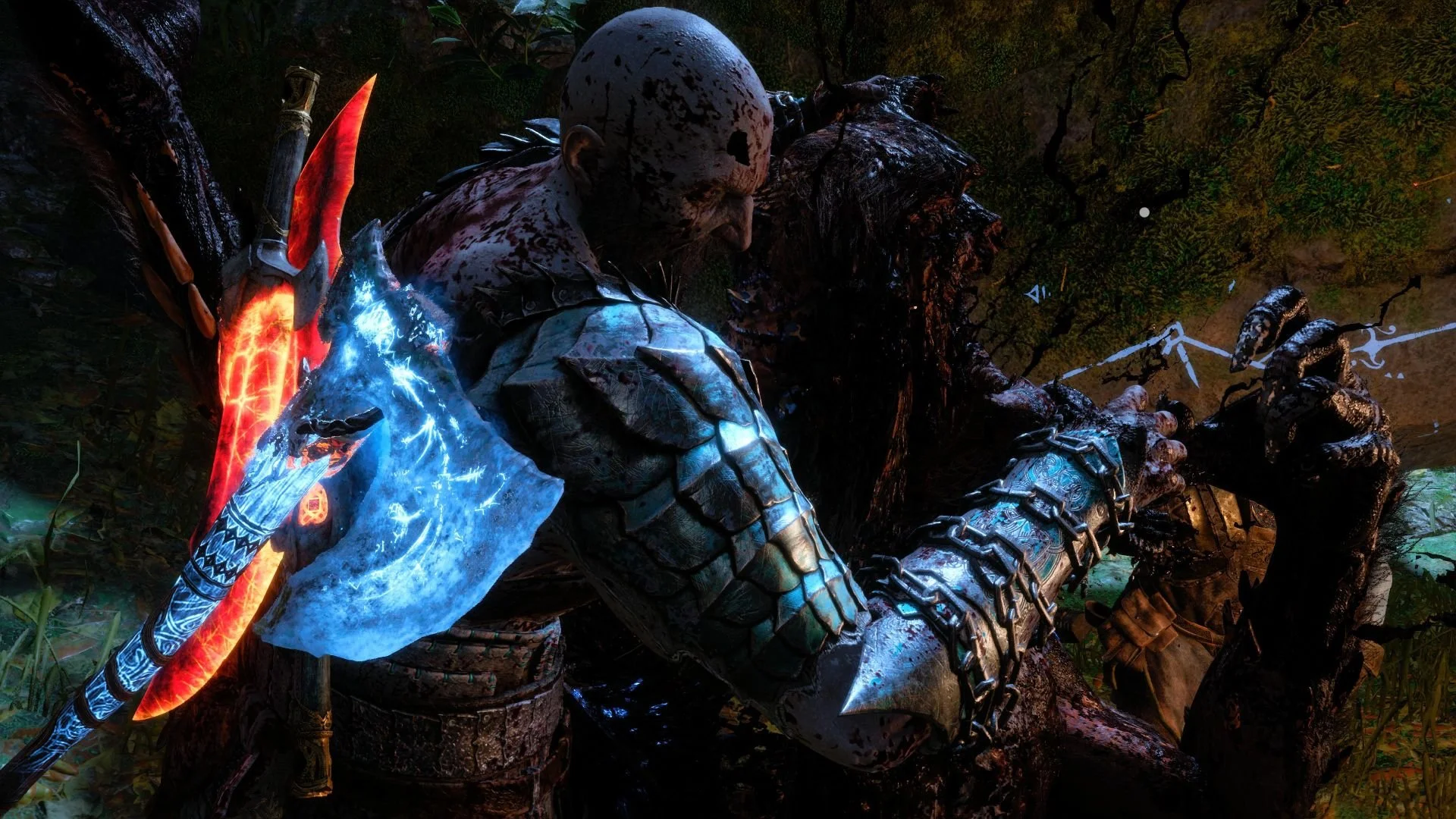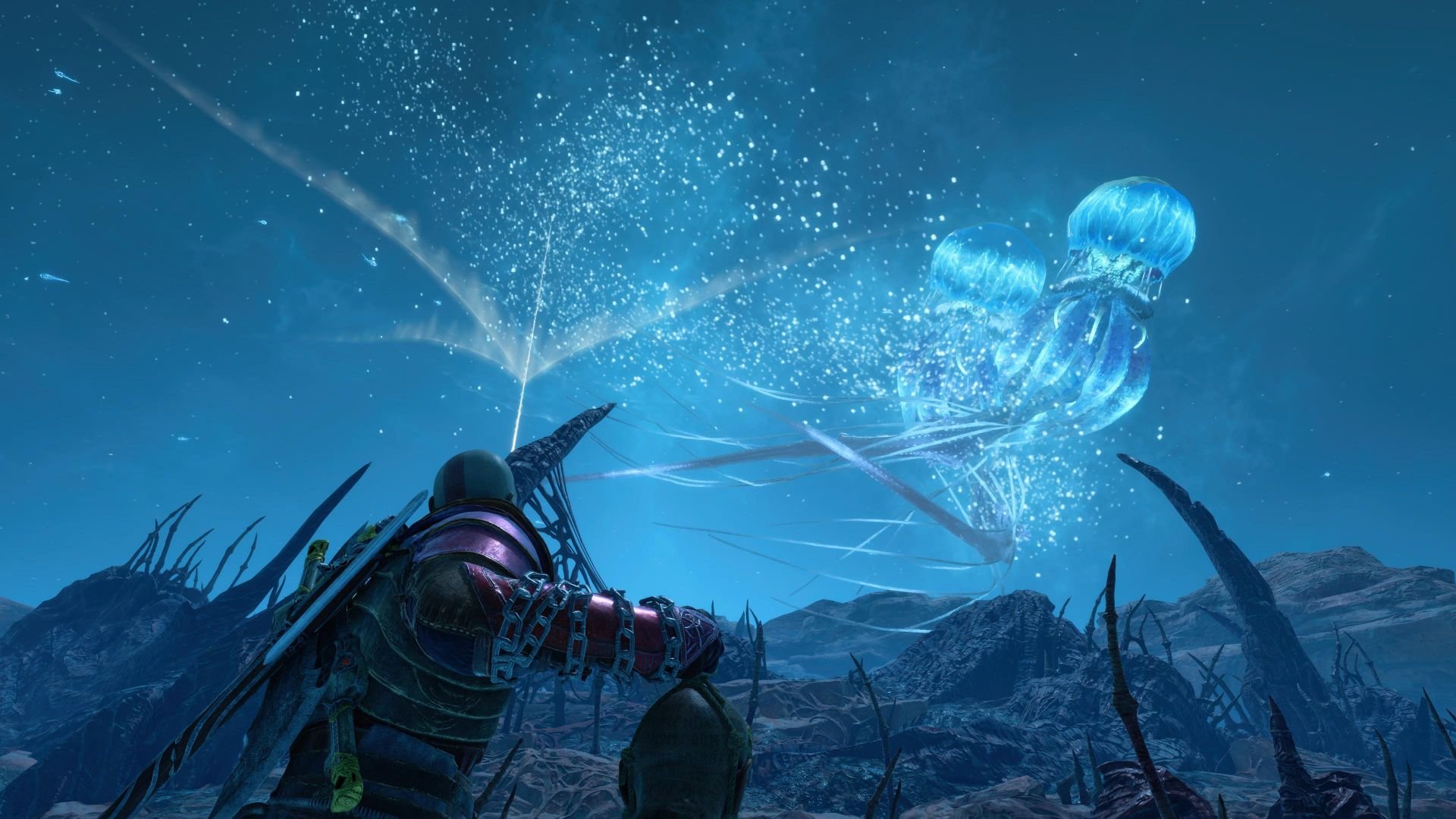“We must be better.“
The following review will be extremely vague/absent on story spoilers, but will discuss some elements of combat/characters to fully detail important parts of the game for the purpose of the review.
During the origins of the God of War franchise, I wouldn’t have imagined that Kratos, the titular God of War, would eventually become this complex and layered character, conveyed with a deeply emotional arc and brought to life through a performance that would rival not only most games, but that of films as well. While 2018’s God of War was a fresh take on the character, built upon the baggage of what had come before, its follow-up in Ragnarök continues to explore the very nature of how Kratos’ past would continue to define his future.
God of War Ragnarök is very much a direct sequel to the 2018 masterpiece in both its core systems and its narrative. So much so that, I’ll be honest, some of that magic feels a tad less impressive this time around. However, when you have a game that plays as stunningly and visceral as we had just a few short years ago, it’s hard to fault Sony Santa Monica for continuing to refine and polish what had worked so well before.
Yes, there are plenty of new systems, characters, skills, realms to explore, and a new weapon to decimate anything foolish enough to get in your way, but the very foundation of what Ragnarök is is still very much rooted in what was already present in 2018’s God of War. If its predecessor didn’t wow you back then, then it’s hard to imagine Ragnarök really changing your mind now. Granted, yes, Ragnarök is debatably the better adventure, packed with even more incredible action, stronger writing, stunning performances, and considerably more heart.
2018’s God of War did a great deal of world-building to prep itself for Ragnarök, setting the stage with prophecy after prophecy, that even though it was hinted at where some parts of this new adventure would take us, its prophesied road was nonetheless satisfying to travel down nonetheless. Ragnarök doesn’t disappoint in any significant way other than its lack of feeling as original as its predecessor did when compared to the series’ previous outings. Still, the fact that Ragnarök manages to improve upon what is nonetheless a masterpiece is nothing short of impressive.
Ragnarök follows both Kratos and his young son Atreus some years after the events of the previous game, with Atreus coming into his own and showing his proud father just how much he has grown. There is a moment in the game’s opening minutes of Kratos barking an order to his son, but after turning to face him, the young man had already taken to task without even hearing the instruction. This time jump also has given Atreus some time to dig into the mysteries surrounding his Giant’s name, “Loki”. While there is much mystery as to what that name still entails and the prophecy attached to it, it is clear that much of what Atreus has done to dive deeper into solving such a mystery has been behind the back of his watchful father.
Both Christopher Judge and Sunny Suljic once again return to their roles with performances that are likely to be remembered for years. Judge commands every scene he is in with his low gravelly delivery, conveying a range of emotions with even the simplest of grunts. Suljic himself has aged alongside the role, sounding considerably older to justify the gap between adventures. Atreus has become far more independent and self-reliable due to his training and this adventure takes note of that, relying on the experience and care that his father has instilled in him to keep him safe when not alongside his parental figure.
As the adventure begins, Ragnarök is already upon us as Fimbulwinter is well underway. This is the prelude to Ragnarök that has affected each of the nine realms in their own unique way, especially that of Midgard as it has been frozen over to the point that navigating the Lake of Nine is now done upon a winter-sled pulled by the spartan father and son’s wolves, Speki and Svanna. While you will certainly return to this massive area time and time again, its larger focus is more to push ahead parts of the narrative and has the game relying on the other realms to truly do much of the heavy lifting.
While Midgard will still play host to some of the game’s biggest moments like it did before, Ragnarök allows us to now visit each of the nine realms in some capacity. Previously, we only had access to Midgard, Alfeim, Helheim, Jotunheim, Muspelheim, and Niflheim. While we will return to those realms via some new and returning areas, we finally get to visit Svartalfheim, Vanaheim, and Asgard, with the latter having a design that I honestly did not see coming.
Ragnarök continues the single-shot epic with a few white flashes and noticeable choke points to allow the game to load, but there isn’t any sort of noticeable cut or transition to a new scene. Even when characters go to sleep it moves them into the dreaming space, allowing us to visit new lands, interact with interesting and notable characters, and even take on parts of the story from a new perspective. As this game was built with the PlayStation 4 in mind, despite the added boost of the PS5 in key performance areas, there are plenty of tight paths to shimmy through, obstacles to lift up and out of the way, and other means that are often ways to hold you up while the game loads the next area.
Your time in each realm will vary greatly and access to them will vary at key points across the roughly 30-35 hour journey. Some locations are drastically bigger than others with some locations existing only as environments for a few side quests, each packed with numerous bits of lore, conversations, activities, and combat encounters. That said, while some of the side quests are remarkably well crafted, there are a few fetch-style quests for several spirits that just don’t measure up.
At various points throughout the adventure, Kratos and Atreus will visit certain realms independently of each other, often with another supporting character as their backup, offering plenty of pairings across characters that were not an active component of combat in the previous game. While Atreus does have his own range of combat skills and abilities, his equipment doesn’t share the same variety or range as that of his father.
With Ragnarök being the central focus of where the plot is aimed, Kratos and Atreus, as well as Mimir, will have to contend with the power of Asgard. This comes in the form of Thor, voiced by Sons of Anarchy’s Ryan Hurst, and Odin, voiced by The Good Doctor’s Richard Schiff, who is an inspired casting and causes Odin to feel immensely different than any other take on the character I’ve seen. Both actors bring such presence to their roles, allowing each of them to feel powerful in their own way, even without lifting a finger.
Thor, packing Mjölnir, is a solid antagonist for Kratos, given the brutal raw strength of the character and one who wields a weapon that Kratos cannot simply snatch away and disembowel him with. And, like Kratos, is layered with a refreshing complexity that thankfully gets explored in some meaningful ways. While I wasn’t sold on the character initially, he soon became a stand-out that I relished in returning to when the story would allow for it, especially the series of events that transpire when we are tasked with tracking Thor down, finding him drunk beyond his limit.
Odin, as the game’s central antagonist, is equally fascinating, cold and calculating, and cutthroat, even if his personality and likable charm often work as a facade to the true inner workings of this madman. Schiff brings such a calm tone to his performance, often presenting him via a conman’s approach to how he delivers his lines, how he interacts with the cast, and the half-truths he spins. especially towards that of Atreus. Like Thor, I wasn’t initially sold on this depiction, but the clever ways in which Odin interacts with the scene and its cast can be downright chilling.
Asgard also continues to bring with it several other additional characters that certainly get their time in the sun. While I’ll leave some of the lesser-known characters to be explored on your own, it is the depiction of Heimdall that was the most shocking as my own experience with the character is dramatically limited to Idris Elba’s role within the Marvel Cinematic Universe. Here, Heimdall, voiced by Scott Porter, is one of the most intriguing of the game, resulting in every scene being even more intense as they went on. His role here is vastly interesting and consistently made for some incredible entertainment.
Ragnarök also brings with it the return of several characters in Mimir, Brok, and Sindri, as well as Freya, who doesn’t make us wait too long for us to see her making an attempt at getting her revenge, as 2018’s God of War ended with the pair killing her son, Baldur. Danielle Bisutti’s return here as Freya is easily on par with Judge and Sulijic, commanding each and every scene she is in. Her role here cannot be understated on just how powerful she is as a character and what Bisutti brings to her performance. I really enjoyed her in the previous title but was blown away by her presence here.
Brok and Sindri were much of the comedic relief in the previous game, and that still remains true here. However, they have far more to do within the main narrative this time around and even have their own side story that was a damn powerful series of events that really gave them the screen time they deserved. While they do still serve as the way to upgrade your gear or take in a brief conversation or two, their push into the spotlight here was well-earned and the game was significantly better for it.
Mimir does offer up some of the same levity and balance to the situations that Kratos and Atreus face as he did in the previous adventure, but his role here is far more of a historian and apart from interacting with a few characters, feels like his role was greatly diminished to allow others to fill that spotlight. I will say that the resolution to a certain riddle proposed towards Mimir was one of the best moments for that character, at least in my opinion.
The last character I’ll tackle, to at least leave some mystery, is Angrboda. Brought to life by Laya DeLeon Hayes of Kung Fu Panda: The Paws of Destiny, and The Equalizer TV series, this Jötunn is likely my favorite character in the game. Her wit and charm are well sold and her interactions with Atreus are often warm and natural. I enjoyed the moments featuring her, but the task of exploring the house during your first outing with her felt a bit tacked on and caused this portion of the game to drag on a bit too much, even despite how important one singular aspect of that whole scene ended up being.
While Ragnarök is filled to the brim with a wealth of interesting characters, the father-son dynamic between Kratos and Atreus is always at the forefront, regardless if the pair are together on screen or not. Atreus is consistently wanting to understand his role in this prophecy and how he can prevent certain things from coming to pass. Meanwhile, Kratos is ensuring that whatever may come to pass that Atreus doesn’t have to suffer the same hardships that Kratos himself has had to endure.
Why Ragnarök excels as much as it does comes down to not just smart writing, but dialogue and emotion that feels perfect for the scene. Videogames often get the side-eye reaction of having their narratives compared to some of Hollywood’s best, but in rare examples such as this, these stories and characters are top-tier and worthy of that comparison. Each scene this game gives us has a purpose and fits together like a puzzle, often at times where the missing piece doesn’t appear until it absolutely needs to.
Whether it is a moment of levity or a scene so emotional that you can’t help but tear up, Ragnarök gives meaning to every character, every motivation, and everything that comes out of their mouth. Both Kratos and Atreus learn from each other and from those around them, allowing their personal arcs to flourish in ways that see each of them grow and results in their relationship forming stronger and more honest bonds between them.
To deal with the upcoming Ragnarök, Kratos, Atreus, Mimir, and a few select others will travel to each of the nine realms, as previously mentioned. While there are some large encompassing realms to explore, such as the swampy woods of Vanaheim, or the almost beach-like Svartalfheim, some realms are disappointingly small or, at the very least, somewhat shallow in their offerings. Musphelheim does have a few key scenes that are impressive, but apart from the Crucible, the playing space of this realm is shockingly tiny. Niflheim shares in the same basic problem as Musphelheim as well with one fairly linear track of map but also as a hub for dealing with a certain type of collectible that you’ll tend to find pretty much everywhere.
As the canoe was a central part of traversing certain realms in the previous title, it returns here to serve that same purpose, as well as being a vessel for characters laying on a lot of exposition. It’s been some time since I last played the original, and to be honest, I have recently reinstalled it to play some for comparison’s sake, but I don’t recall hating the canoe or really being too disturbed by it. However, in Ragnarök, I grew tired of it rather quickly, largely due to wanting to explore around the map while my main objective was still set and then it instantly turning around when I would accidentally hit the “track objective” swipe on the trackpad when I was only wanting to bring the map up. It’s a specific annoyance to likely just myself but was an issue that made me constantly despite exploring around in it and with the dog-sled, for the same issue.
Each realm does have its fair share of progression-blocking puzzles such as special doors that require a bit of magic manipulation to using a new weapon of Kratos’ to mind the gap on some out-of-reach places. I never found myself stuck at anything in particular for too long, but I will say that the best puzzles, the ones that were deceptively clever, were the ones that used a bit of out-of-the-box thinking that happened far too infrequently.
While this does lend itself to combat, part of completing those puzzles is through the use of two new arrow types that are available regardless of which archer-based support character you have alongside Kratos. Runic arrows can shoot down special green-reflective objects whereas Sigil arrows, which are a type of Runic Arrow that applies a Hex status effect to your enemies, can also be used to transport elements from one source to the next, as well as destroying vine-like blockers that restrict certain paths or treasure. Another use for the Sigil arrow is keeping the frost build-up of Kratos’ axe on triggers that require its presence, allowing you to pull back the axe and its effect is still present. The variety in which each of these arrows affects puzzles is remarkably well-conceived, even if some environments often have far too simple solutions that are disappointingly too obvious.
A point of contention when it comes to the puzzles is that while some of these puzzles are, as I’ve mentioned, sometimes far too simple, that doesn’t stop each companion character from almost instantly shouting the solution to you. There is a puzzle option in the settings, but this isn’t a setting to silence the NPC but to allow some puzzles to have more time given to trigger certain components. In Horizon: Forbidden West, Aloy would constantly talk to herself, often saying things like “Oh, now how do I get up there..” before you even had the chance to know there was an “up there.” Here, Atreus and a few others will exclaim the intended method to Kratos before you’ve really had any time to even notice there is a puzzle there in the first place. This is honestly something I see being patched because as it stands now, it feels like the game isn’t confident in its player.
While many will come for the story, its characters, and the world-building of what Ragnarök represents here, God of War has always been an intense affair of blood and carnage, tearing foes limb from limb and using the Blades of Chaos to burn their victim alive. To that end, combat excels here in a lot of the same ways present in the previous game. Some attacks and skills return alongside a ton of new moves, abilities, and a whole new weapon to add to Kratos’ arsenal.
That said, not much has fundamentally changed for the Leviathan Axe or the Blades of Chaos, other than some additional new abilities, new attachments, and new runic attacks. Enemies can often have a special decoration atop their health bar that indicates which weapon is needed to break through it, such as using the Blades of Chaos to burn away at a frost-covered health bar. While the shield doesn’t have its own skill tree this time around, it can still find its way into combat by being able to equip either a shield that is great for dishing out attacks or parrying a strike to stun your foe for a quick follow-up.
While I won’t dive too deeply into the third weapon choice, it allows Kratos to have somewhat of a minor aspect of a ranged attack other than throwing out his axe or the limited reach of the Blades of Chaos. The ability to send out echoes of the weapon to then have them explode, allows this weapon to have some interesting uses when combined with the familiar duo that Kratos starts the game with. I also found that this new addition arrived perfectly when it needed to as while the axe and blades are great for what they offer, this new arrival feels far different enough that it really opens up combat and honestly was my go-to weapon for a long while, especially as I upgraded it more and more. I’ll stress that the below picture is the only glitch I really had with the game, with the very weapon I was upgrading simply not appearing.
You’ll come to rely on Brok and Sindri a lot to enhance your weapons as well as your gear, with Kratos having more options to equip than ever before. While I am still not a fan of dressing Kratos up in full-body armor, as most of the options here are downright hideous, the single-shoulder aesthetic options are easily the best visually, and several of them saw all those important numbers go up, so they were sound options as far as I was concerned. Kratos can mix and max Chest, Wrist, and Waist armor like before, and Atreus will also have options as well, however; they are limited and are just a single full armor set than any sort of split pieces.
Kratos can also wear an amulet that allows you to repair it and equip a variety of different enchantments. Most of these enchantments have perks that are locked behind needing to have three of a similar type. And, unless I was missing something, I never saw how to confirm the types you were crafting from one another. These perks range from reducing cooldowns to increasing melee damage across a variety of different factors.
With a properly equipped Kratos, upgraded to unleash hell, Ragnarök continues with the same overall combat as its predecessor with small but effective changes to refine an already great system. There are devastating finishers based on the weapon and enemy, with environmental assists such as pulling a broken tree from its roots to crush whoever is on the receiving end of it. The axe still feels satisfying to fly back to you, even if again, some of that magic isn’t as pronounced or impactful this time around. Every cleave of the axe has the weight you need of it, seeing Kratos lodge the bulk of its blade into the neck and then, in one swift and brutal motion, tear his foe in two. Regardless of performing some of the same attacks, moves, and finishers dozens of times, I never found myself bored of the visceral brutality on display, especially with the addition of new attacks and weapons.
The Blades of Chaos feel more designed with an approach to the earlier games while still maintaining much of their moveset and feel from their return in 2018. You can pull and lasso toward opponents, even spinning the chain around and then burn them alive with some frantic button taps, the same button to which you can use for the Leviathon axe to charge up its frost capabilities.
While Atreus won’t always be at your side, with a few guest characters coming to aid the spartan warrior, the assistance of each character will vary on who it is. Each core companion has a set of skills that can be upgraded to further enhance their own capabilities, with Atreus having a greater deal of options this time around, especially when you are behind the controls of the young demi-god himself. Ragnarök, like 2018’s God of War, makes good use of these companions by allowing them to play around in combat and wait on your command to shoot an arrow or long-press the button to have them perform stronger and more varied attacks.
Across the nine realms, Kratos and Atreus will contend with a decent variety of enemies, both big and small. Knowing which weapons to use to get the edge in battle is certainly part of the strategy, especially on harder difficulties, but when it comes to God of War, many are far more interested in the quality of the boss fights themselves. While few are going to compare to the brutality of taking on Baldur, except for one battle that benefits from the newly acquired weapon, I found the best fights in Ragnarök to be when Kratos was taking on some sort of creature or beast, especially one of the four-legged variety. The boss in question felt like a classic God of War battle with Kratos taking on something several times his size; it was a riot. While the other battles are fine, I felt they didn’t quite offer us up anything we haven’t done countless times before.
Despite God of War Ragnarök being built for the PS4 and then enhanced for PS5, this is often a jaw-dropping adventure. I still have issues with some NPC’s having drastically lower quality models than their cutscene counterparts or even the player models of Kratos and Atreus, but this is limited to just a few moments, including one that changed from the original trailer to what is present in the game now. Regardless, while 2018’s God of War was visually impressive to no end, Ragnarök does the near-impossible job of looking better across the board, largely due to vastly better lighting and detail.
God of War Ragnarök, much like many of Sony’s recently released games or remakes, has a full suite of accessibility options to make the game functional or even playable for many of its players. From presets that offer some or full support of issues pertaining to motor skills to visual assists, the implementation here is nonetheless welcoming. While there are some basic essentials here such as difficulty modes, controller re-mapping, auto-loot pickup, to holding down contextual buttons instead of slamming away at them, there are numerous settings present here that are absolute must-haves for a wide range of disabled gamers. For a full detailed breakdown of all accessibility settings, check out the PlayStation blog here.
God of War Ragnarök takes the almost impossible job of improving upon a game that was already stunning and succeeds where it truly needed to. I don’t think it will convert those who were not on board with 2018’s drastically new direction, but for those already invested, Ragnarök is a triumph. I have small nitpicks with certain things sure, such as some realms given tiny explorable areas to have ‘Explore all nine realms” as some sort of back-of-the-box quote, but again, this is a small nitpick when everything else this game does is remarkably impressive.
Ragnarök does a solid job at wrapping up the Norse Mythology chapter for Kratos and Atreus, giving us more to look forward to should we revisit the series again. There are a few portions of the story that do feel somewhat pushed aside, but the swings made towards the main plot, towards the relationship between father and son are easily knocked out of the park with the performances to back it up. While some aspects of this game do feel like Sony played it largely safe in regards to making any broad strokes of change, the refinement that comes from sticking so closely to the 2018 game and what it offers can be seen as either a fantastic technical choice or a disappointing one, for those expecting a fresh and original sequel. While I fully understand the latter and agree with it to a certain degree, Ragnarök is still nonetheless an incredible experience that is one of Sony’s best titles in years.
Developer - Santa Monica Studios. Publisher - Sony Interactive Entertainment. Released - November 9th, 2022. Available On - PlayStation 4/5. Rated - (M) Blood and Gore, Intense Violence, Strong Language. Platform Reviewed - PlayStation 5. Review Access - God of War Ragnarök was purchased for review.


